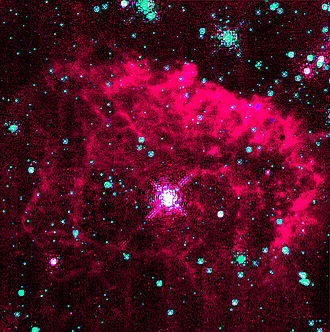Pistol Star
Hypergiant star in Sagittarius From Wikipedia, the free encyclopedia
The Pistol Star (or V4647 Sagittarii) is an extremely luminous blue hypergiant star, one of the most luminous and massive known stars in the Milky Way. It is one of many massive young stars in the Quintuplet cluster in the Galactic Center region. The star owes its name to the shape of the Pistol Nebula, which it illuminates. It is located approximately 25,000 light-years from Earth in the direction of Sagittarius. The star has a large mass comparable to V4998 Sagittarii and a luminosity 3.3 million times that of the Sun (L☉). It would be visible to the naked eye as a 4th-magnitude star if it were not for the interstellar dust near the Center of the Milky Way that absorbs almost all of its visible light.
| Observation data Epoch J2000 Equinox J2000 | |
|---|---|
| Constellation | Sagittarius |
| Right ascension | 17h 46m 15.3s[1] |
| Declination | −28° 50′ 04″[1] |
| Apparent magnitude (V) | >28[2] |
| Characteristics | |
| Spectral type | LBV[2] |
| Apparent magnitude (J) | 11.828[1] |
| Apparent magnitude (H) | 8.920[1] |
| Apparent magnitude (K) | 7.291[1] |
| Variable type | cLBV[3] |
| Astrometry | |
| Radial velocity (Rv) | +130[2] km/s |
| Distance | 7,700[4] pc |
| Details | |
| Mass | 125[5] M☉ |
| Radius | 420[5][a] R☉ |
| Luminosity | 3.3 million[5][6] L☉ |
| Temperature | 11,800[7]–12,000[5] K |
| Metallicity [Fe/H] | 0.1[8] dex |
| Age | ~4[9] Myr |
| Other designations | |
| V4647 Sgr, qF 134, 2MASS J17461524-2850035 | |
| Database references | |
| SIMBAD | data |
Properties
Summarize
Perspective

The Pistol Star was discovered using the Hubble Space Telescope in the early 1990s by Don Figer, an astronomer at UCLA. The star is thought to have ejected almost 10 solar masses of material in giant outbursts perhaps 4,000 to 6,000 years ago (as observed from Earth). Its stellar wind is over 10 billion times stronger than the Sun's. Its exact age and future are not known, but it is expected to end in a brilliant supernova or hypernova in 1 to 3 million years. The mass is equally uncertain, thought to have been up to 200 times the Sun when initially formed but now considerably less due to extreme mass loss although likely still over 100 times the Sun.[10] Modelling the star itself to match its spectrum gives a mass of 27.5 M☉,[7] while matching its current properties to an evolutionary model gives a much higher mass (86–92 M☉).[11] Earlier studies once claimed the Pistol Star as the most massive star known at around 250 M☉.[4]

Later studies have reduced its estimated luminosity making it a candidate luminous blue variable about 1.6 million L☉ (one third as luminous as the binary star system Eta Carinae), hence a radius of 306 R☉ based on an effective temperature around 12,000 K,[7] or as high as 3.3 million L☉, hence a correspondingly larger radius of 420 R☉.[5][a][12] Even so, it radiates about as much energy in 10 seconds as the Sun does in a year.
A close point source has been discovered hidden in the surrounding nebulosity, but there has been no confirmation of this being a star or whether it is physically associated.[13]
See also
Notes
- Applying the Stefan–Boltzmann law with a nominal solar effective temperature of 5,772 K:
References
External links
Wikiwand - on
Seamless Wikipedia browsing. On steroids.


